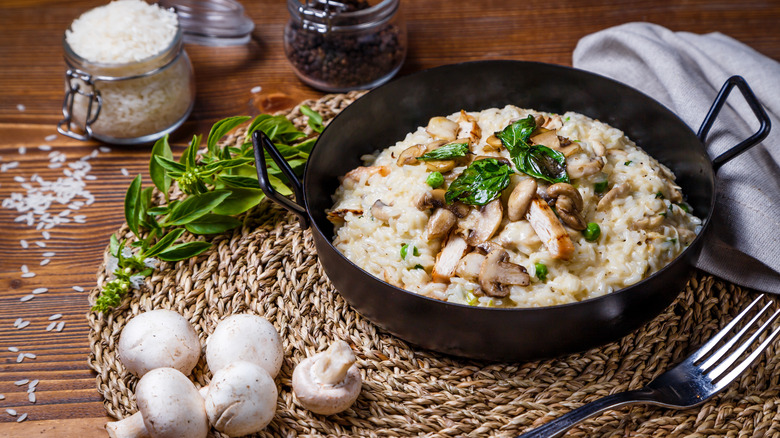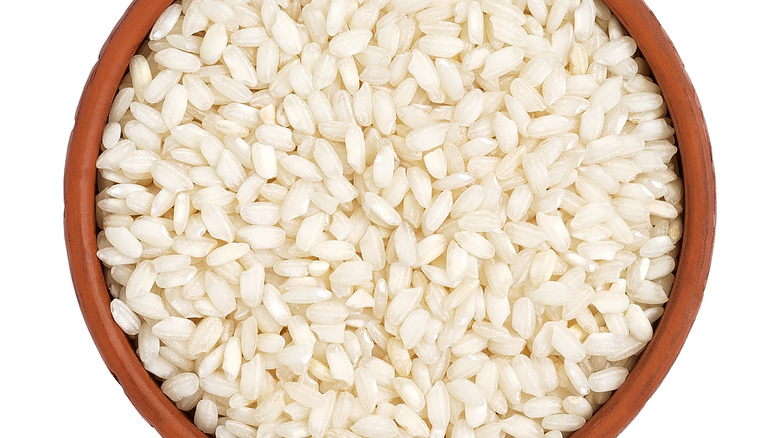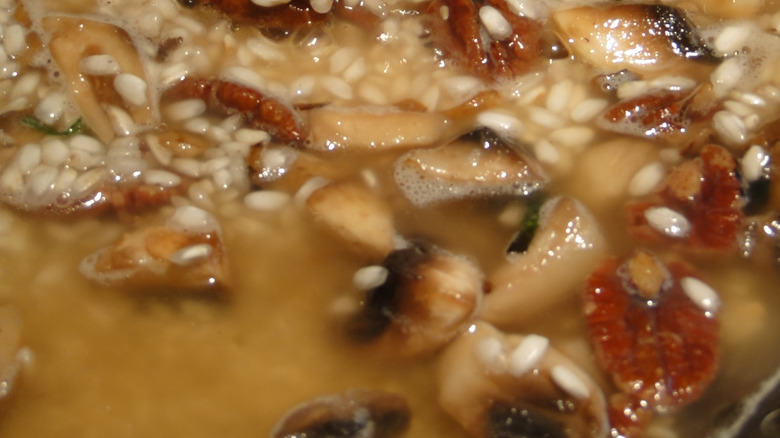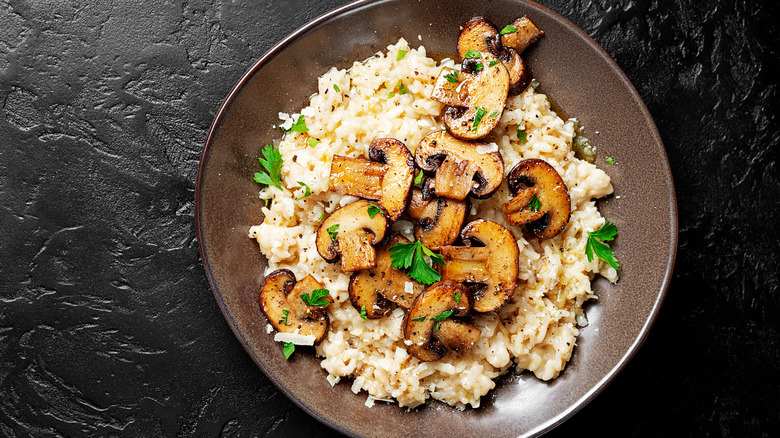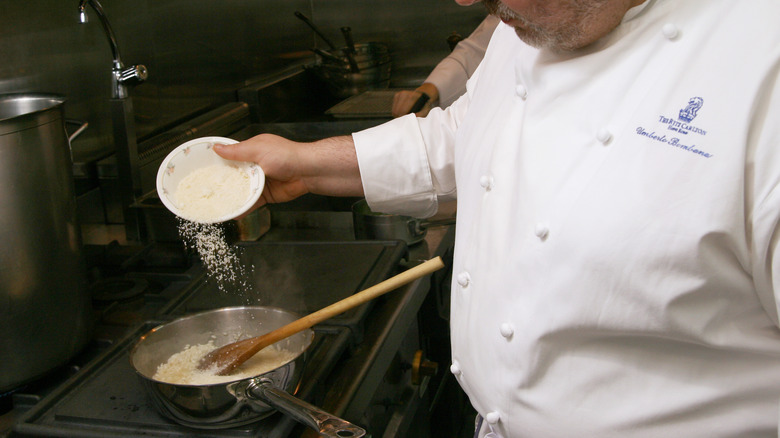What Is Risotto And What Does It Taste Like?
If you love rice, chances are you'll fall in love — if you haven't already — with risotto, the creamy Italian rice dish that is prepared by first toasting rice grains in butter and then slowly adding small amounts of hot liquid (usually a broth of some kind) and stirring until the liquid is absorbed by the rice. Then, some cheese might be added (via Serious Eats). As the rice cooks, it gives up its starch, which gives the dish a creamy, rich texture; more liquid is added each time the previous broth is absorbed, until the risotto is cooked.
Risotto is a child of many cultures — the rice is Asian and the saffron which is used at times, is Spanish. Gourmet Traveller, which looks at the history of risotto, says that the earliest Italian recipes involving rice were desserts; but this likely changed around the 15th century, when a Milanese cook named Maestro Martino talks about a rice dish cooked in a meat-based stock and mixed with eggs. It wasn't until the 1800s that a missionary introduced the short-grained Japonica rice variety into Italy that hybrids were created, setting the stage for risotto as we now know it.
What kind of rice can you use for risotto?
Serious Eats describes the perfect risotto as a bit saucy and should "flow like lava" when the plate it sits on is tilted. And if you ask The Chicago Tribune's Peter Kump, he might have told you back in 1988 that risotto was a dish that belongs in the "realm" of the home cook, simply because the dish requires serious levels of attention needed to turn hard grains into gorgeous, creamy bits bursting with flavor by stirring non-stop until the rice was cooked through.
Those who cook and love risotto say the best types of rice to use share the same qualities; they are fat, short- or medium-grained rice with plenty of amylopectin or starch, making it robust enough to stand up to stirring. Among the more popular varieties of rice, you can use are bomba, which is short-grained and is normally used in the making of a Spanish paella; arborio, which tends to go mushy quite quickly and can result in a rather thick sauce; and carnaroli, which holds its shape, and yet manages to deliver on being creamy. The Kitchn says there are also other varieties that include Vialone Nano and maratelli, but these can be more difficult to find.
How is risotto made?
Admittedly, making risotto isn't as simple as putting together a regular serving of rice which, for most households, involves measuring rice into a cooker and adding the required amount of water. Regardless, there are several ways to make risotto. Serious Eats describes what it calls "old school risotto" which involves mixing warm broth in with rice that has been toasted with either with butter, olive oil (or both), then adding broth just one ladle at a time while the risotto is being stirred. When the required amount of soup stock is used up, you'll be left with a flavorful dish full of carby goodness.
Noted food writer J. Kenji López-Alt says there is a quicker way to pull together the perfect risotto, and this is done by throwing the rice and nearly all the stock in one wide, shallow pan, then stirring the mixture once during the cooking process. Once the rice is cooked through, he proposes that the reserved soup stock can then be added to bring the rice to its desired consistency. The method may cause traditionalists to throw their hands in the air; but experimentation shows that López-Alt's method can work. It could present a quicker, more practical, albeit less romantic way of getting risotto from stovetop to tabletop.
Nutritional information about risotto
Like other types of rice (or pasta for that matter), risotto is a blank canvas that will take on the flavors of whatever it is you cook with it. If you were to look at risotto on its own, a quarter cup of arborio cooked up with water will pack 160 calories, 1 gram of fat, 35 grams of carbs, and 5 grams of protein with no sodium or cholesterol in sight (via Livestrong).
Risotto prepared to your liking will be, as you might imagine, a different creature altogether. For instance, Livestrong also says that a serving of lobster risotto — which amounts to about three-quarters of a cup — will have 300 calories, 17 grams of fat (or 45% of the recommended daily amount), and a whopping 600 mg of sodium (25% of RDA). SparkRecipes lists a serving of creamy mushroom risotto as having 210.5 calories, 10.2 grams of fat, 12.7 grams of carbs, 11.8 grams of protein, and 1,104.7 mg of sodium. While we wouldn't tell you to stay away from these delights, it's something to consider as you dig in.
Variations on risotto
Visualizing how risotto is cooked could well be the most challenging part of making this classic Italian dish, which can be made more creamy with the addition of cheese and butter. While some people may not see the need, cream can also be added in to make the dish richer.
If you're not excited by the thought of consuming a bowl of rice with aromatics and hints of chicken, beef, or vegetable broth, don't worry, because there is plenty you can do to add oomph to your risotto. Possible add-ins include roasted shrimp, crumbled sausage, roast chicken, or seared scallops, all of which are added before the risotto is served (via The Kitchn). If your craving is for a vegetarian risotto, Gordon Ramsay offers up a risotto topped with mushrooms that have been cooked in olive oil, and where the rice has been toasted with olive oil, and to which wine has been added (via Hell's Kitchen Recipes).
